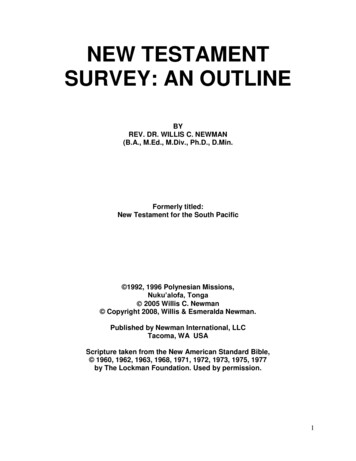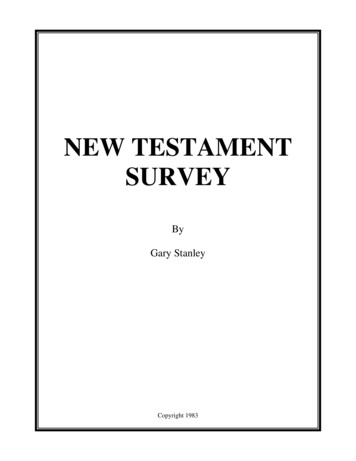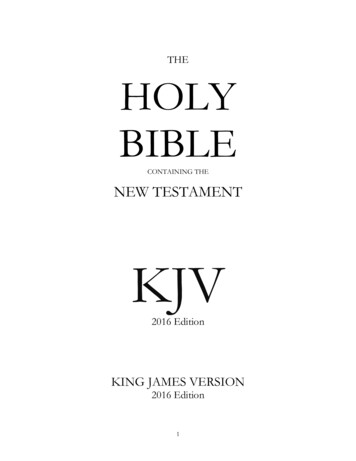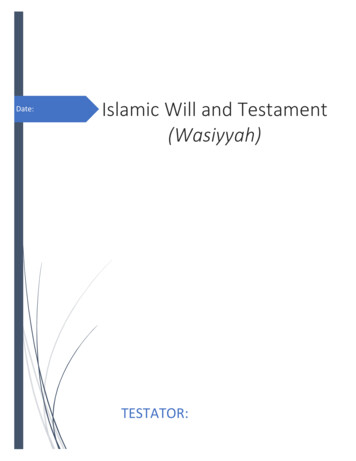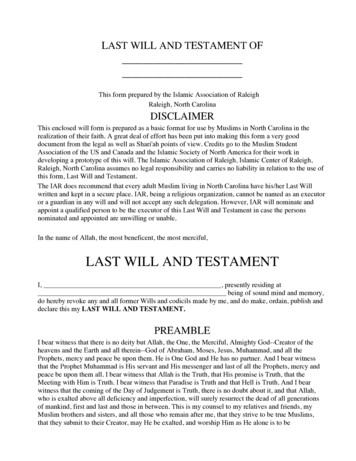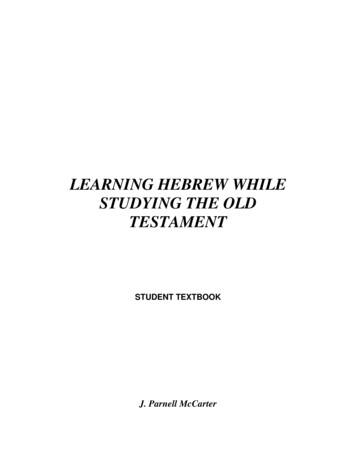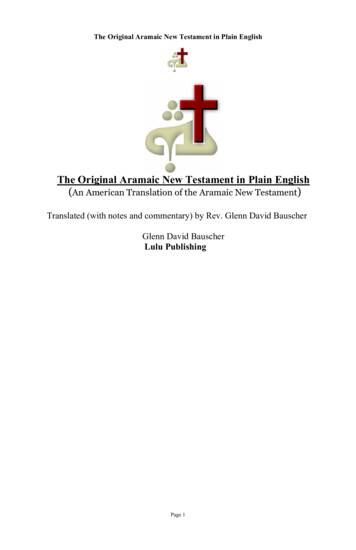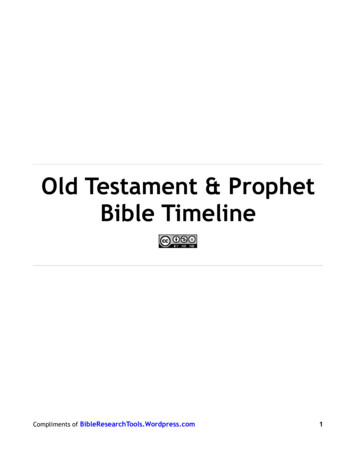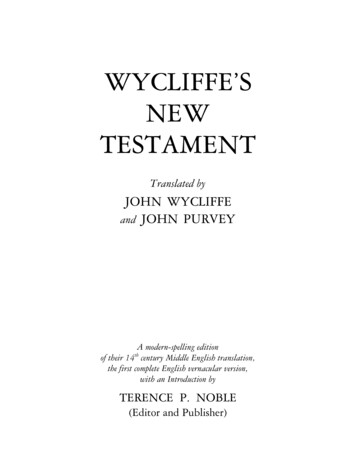
Transcription
WYCLIFFE’SNEWTESTAMENTTranslated byJOHN WYCLIFFEand JOHN PURVEYA modern-spelling editionof their 14 century Middle English translation,the first complete English vernacular version,with an Introduction bythTERENCE P. NOBLE(Editor and Publisher)
forQUYNH M. DANG,whose encouragement, support, andpatience, made this booka reality.in memory ofLOUISPublished by Terence P. NobleCopyright August 2001 by Terence P. NobleAll rights reserved. No part of this book may be reproducedin any way without written permission from the publisher.National Library of Canada Cataloguing in Publication DataBible. N.T. English (Middle English). Wycliffe. 2001Wycliffe’s New Testament translated by John Wycliffe and JohnPurveyIncludes bibliographical references.ISBN 0-9697670-2-1I. Wycliffe, John, d. 1384. II. Purvey, John. III. Noble, Terry,date IV. Title.BS2035 2001225.5’201C2001-911237-8Additional copies available from:Terry Noble802-1875 Robson Street,Vancouver, B.C.V6G 1E5(phone #: 604-689-7095)This Limited Edition printed August 2001at Ward Printing Inc., Vancouver, B.C.V6B 2M1 (phone #: 604-683-0858)
Table of ContentsIntroductionvWycliffe’s New TestamentThe Gospel of MatthewThe Gospel of MarkThe Gospel of LukeThe Gospel of JohnDeeds of ApostlesThe Epistle of Paul to the RomansThe First Epistle of Paul to the CorinthiansThe Second Epistle of Paul to the CorinthiansThe Epistle of Paul to the GalatiansThe Epistle of Paul to the EphesiansThe Epistle of Paul to the PhilippiansThe Epistle of Paul to the ColossiansThe First Epistle of Paul to the ThessaloniansThe Second Epistle of Paul to the ThessaloniansThe First Epistle of Paul to TimothyThe Second Epistle of Paul to TimothyThe Epistle of Paul to TitusThe Epistle of Paul to PhilemonThe Epistle to the HebrewsThe Epistle of JamesThe First Epistle of PeterThe Second Epistle of PeterThe First Epistle of JohnThe Second Epistle of JohnThe Third Epistle of JohnThe Epistle of JudeThe Apocalypse of 8898968999419559719819959979991004Glossary to “Wycliffe-Purvey”Endnote: Regarding the “Early Version”In ConclusionBibliographyAbout the Author10681086108810901092iii
IntroductionThen Jesus spake to the people By the sea or on a hilltop, in the temple or at the well, to individuals and tomultitudes alike, when Jesus walked the earth, he spoke to people in words theycould understand.Paul’s actual letters were written in Greek, the everyday language of those towhom they were sent. Thirty years later, the same would be true of the originalGospels.1300 years later, in England, the Word of Truth was written only in Latin, aforeign language to 99% of that society. Indeed, Latin was only understood bysome of the clergy and the well-off, and the relatively few who were universityeducated. As well, the Church’s “Divine Commission” – to preach the Wordand save souls – had been transformed into a more temporal undertaking: theall-consuming drive to wield authority over every aspect of life and, in theprocess, to accumulate ever-greater wealth.John Wycliffe, an Oxford professor and theologian, was one of those few whohad read the Latin Bible. Though a scholar living a life of privilege, henevertheless felt a special empathy for the poor and the uneducated, thosemultitudes in feudal servitude whose lives were “short, nasty, and brutish”. Hechallenged the princes of the Church to face their hypocrisy and widespreadcorruption – and to repent. He railed that the Church was no longer worthy tobe The Keeper of the Word of Truth. And he proposed a truly revolutionaryidea:“The Scriptures,” Wycliffe stated, “are the properly of the people and onewhich no party should be allowed to wrest from them Christ and his apostlesconverted much people by uncovering of scripture, and this in the tongue whichwas most known to them. Why then may not the modern disciples of Christgather up the fragments of the same bread? The faith of Christ ought thereforeto be recounted to the people in both languages, Latin and English.”Wycliffe believed that with the Word of Truth literally in hand, eachindividual could work out his or her own salvation, with no need for any humanor institutional intermediary.And so John Wycliffe and his followers, most notably John Purvey, hissecretary and close friend, translated Jerome’s Vulgate, the “Latin Bible”, intothe first English Bible. Their literal and respectful translation was hand-printedaround 1382. Historians refer to this as the “Early Version” of the “WycliffeBible”.The Church princes, long before having anointed themselves sole (soul?)arbitrator between God and man, condemned this monumental achievement asheretical – and worse:v
Introduction“This pestilent and wretched John Wycliffe, that son of the oldserpent endeavoured by every means to attack the very faith and sacred doctrineof Holy Church, translated from Latin into English the Gospel that Christ gave tothe clergy and doctors of the Church. So that by his means it has become vulgarand more open to laymen and women who can read than it usually is to quitelearned clergy of good intelligence. And so the pearl of the Gospel is scatteredabroad and trodden underfoot by swine.”(Church Chronicle, 1395)The Church princes decreed that Wycliffe be removed from his professorshipat Oxford University, and it was done. Two years later, his health broken, hedied.In the decade following John Wycliffe’s death, his friend John Purvey revisedtheir Bible. The complete text, including Purvey’s “Great Prologue”, appearedby 1395. But portions of that revision, in particular the Gospels and other booksof the New Testament, were likely circulated as early as 1388.Historians refer to this as the “Later Version” of the “Wycliffe Bible”. Thisvernacular version retained most, though not all, of the theological insight andpoetry of language found in the earlier, more literal effort. But it was easier toread and understand, and quickly gained a grateful and loyal following. Eachcopy had to be hand-written (Gutenberg’s printing press would not be inventedfor more than half a century), but this did not deter widespread distribution.The book you now hold in your hands is that Bible’s New Testament (withmodern spelling).For his efforts, the Church princes ordered John Purvey arrested and deliveredto the dungeon. He would not see freedom until he recanted of his “sin” –writing the English Bible. His spirit ultimately broken, he eventually did recant.Upon release, he was watched, hounded at every step, the Church princesdetermined that he would tow the party line. His life made a living hell,eventually the co-author of the first English Bible disappeared into obscurity anddied unknown.But the fury of the Church princes was unrelenting. Edicts flew. JohnWycliffe’s bones were dug up – and burned. Wycliffe’s writings were gatheredup – and burned. All unauthorized Bibles – that is, those in the Englishlanguage – were banned. All confiscated copies were burned. Those who copiedout these Bibles were imprisoned. Those who distributed these Bibles wereimprisoned. Those who owned an English Bible, or, as has been documented,“traded a cart-load of hay” for part of one, were imprisoned. And those faithfulsouls, who refused to “repent” the “evil” that they had committed, were burnedat the stake, the “noxious” books they had penned hung about their necks to beconsumed by the same flames. In all, thousands were imprisoned and manyhundreds executed. Merry olde England was engulfed in a reign of terror. Allbecause of an English Bible. This Bible.vi
IntroductionBut the spark that John Wycliffe, John Purvey, and their followers hadignited would not, could not, be extinguished. The Word of Truth was copied,again, and again, and again. The Word of Truth was shared, from hand, tohand, to hand. The Word of Truth was spoken, and read, and heard by thecommon people in their own language for the first time in over 1300 years. Atlong last, the Word of Truth had been returned to simple folk who were willingto lose everything to gain all.And so the pearl of the Gospel was spread abroad and planted in their hearts by theservants of God 216 years after Purvey’s revision appeared, somewhat less than a century afterMartin Luther proclaimed his theses (sparking the Protestant Reformation) andHenry VIII proclaimed his divorce (thereby creating the Church of England),what would become the most famous, enduring, beloved and revered translationof the Bible, the “Authorized” or “King James Version” (KJV), was published in1611.In their preface, “The Translators to the Reader”, in the 1st edition of theKJV, the 54 translators detail many sources utilized and arduous effortsundertaken to achieve their supreme accomplishment. Interestingly enough,they make scant mention of even the existence of earlier, unnamed Englishversions. And they make no specific reference to the work of John Wycliffe andJohn Purvey. It is not my desire or intention here to speculate on the politicoecclesiastical reasons for this omission, simply to state its fact.From 1611 until today, historians of the English Bible have uniformlyfollowed the lead of the KJV translators, and have either ignored, dismissed ordenigrated John Wycliffe and John Purvey’s contributions to, and influencesupon, that ultimate translation, the KJV. To wit:“The Bible which permeated the minds of later generations shows no directdescent from the Wycliffite versions; at most a few phrases from the later versionseem to have found their way into the Tudor translations Tyndale’s return to theoriginal languages meant that translations based on the intermediate Latin of theVulgate would soon be out of date.”(Cambridge History of the Bible, Vol. 2, p. 414.)When you finish reading this present volume, you may reach a differentconclusion.Regarding Wycliffe’s New TestamentWycliffe’s New Testament comprises the New Testament found in extant copiesvii
Introductionof the “Later Version” of the “Wycliffe Bible”, with modernized spelling, placedalongside the King James Version, for handy reference and easy comparison. Formore than 99% of Wycliffe’s New Testament, word order, verb forms, words initalics, and punctuation are as they appear in the “Later Version”. In addition,words and phrases found only in the “Early Version” are presented within squarebrackets, “[ ]”, to provide more examples of Wycliffe’s and Purvey’sgroundbreaking scholarship, as well as to often aid reader comprehension andimprove passage flow (more on this below).Authorship of both versions of the “Wycliffe Bible” is still debated in somecircles. In Wycliffe’s New Testament, the up-dated “Later Version” is respectfullytitled “Wycliffe-Purvey” to acknowledge the essential contributions of JohnWycliffe and John Purvey in the effort to bring the English Bible to the Englishpeople. The late date of “1395” was chosen to indicate that the text is drawnfrom many variant copies produced over the extended period of revision.Middle EnglishThe “Wycliffe Bible” was written in Middle English in the last two decades ofthe 14th century. “Middle English” is the designation of language spoken andwritten in England between 1150 and 1450. The year 1300 is used to divide theperiod into “Early Middle English” and “Late Middle English”. During the timeof Late Middle English, there were 5 regional dialects in England (with Londonitself eventually developing a sixth distinct dialect). Elements of at least threedialects can be found in the “Later Version” of the “Wycliffe Bible”.What does one encounter reading the “Later Version”? An alphabet with awidely used 27th letter, “3”. A myriad of words which today are obsolete(“disparple”: “to scatter”), archaic (“culver”: “dove”), or at best, strangely spelled(“vpsedoun”: “upside-down”). Spelling and verb forms that are not standardizedbecause they are phonetic to different dialects. (The word “saw” is spelled adozen ways, and differently for singular and plural nouns; similarly the word“say”. “Have take” and “have taken” are found in the same sentence, as are “hadknow” and “had known”.) Prepositions and pronouns that often seem misplacedand incorrectly used. (“In”, “of”, “to”, “what”, “which”, and “who” again andagain seem wrongly situated. “Themself” and “themselves”, and “youself” and“yourselves”, regularly appear in the same sentence.)Capitalization,punctuation, and other grammatical conventions that are rudimentary by today’sstandards and vary greatly from sentence to sentence. (For example, past tensesare made by adding nothing to the present tense, or an “e”, “en”, “id”, “ede”,and still other suffixes.) One encounters, in short, a seemingly incomprehensiblechallenge within (what will become) a single verse of scripture.And so the reason for “Wycliffe-Purvey”. “Wycliffe-Purvey” is the “LaterVersion” of the “Wycliffe Bible” with irregular spelling deciphered, verb formscomprehended and made consistent, and numerous grammatical variationsviii
Introductionstandardized. “Wycliffe-Purvey” is the key that unlocks the amazing secretsfound within the “Wycliffe Bible”.Three types of words: obsolete, archaic and precursorsAs indicated above, when the spelling is modernized, three types of words arediscovered in the “Later Version”: obsolete (“dead”, unknown and unused forcenturies), archaic (old-fashioned, now chiefly used poetically), and, the vastmajority, “precursors”, that is, strangely spelled forerunners of words that weuse today. To comprehend the text, each group of words must be dealt with in aparticular way.Obsolete WordsApproximately 5% of the words in the “Later Version” are “dead” words thatare neither presently used, nor found in current dictionaries. To fully understandthe text, these obsolete words must be replaced. (In a handful of instances, theKJV follows the “Later Version” in the use of an obsolete or archaic word –words such as “holden”:“held”; “washen”:“washed”; “wot”:“know”;“wist”:“knew”; “anon”:“at once”; and “
“The Bible which permeated the minds of later generations shows no direct descent from the Wycliffite versions; at most a few phrases from the later version seem to have found their way into the Tudor translations Tyndale’s retur n to the original languages meant that translations based on the intermediate Latin of the Vulgate would soon be out of date.” (Cambridge History of the Bible .
